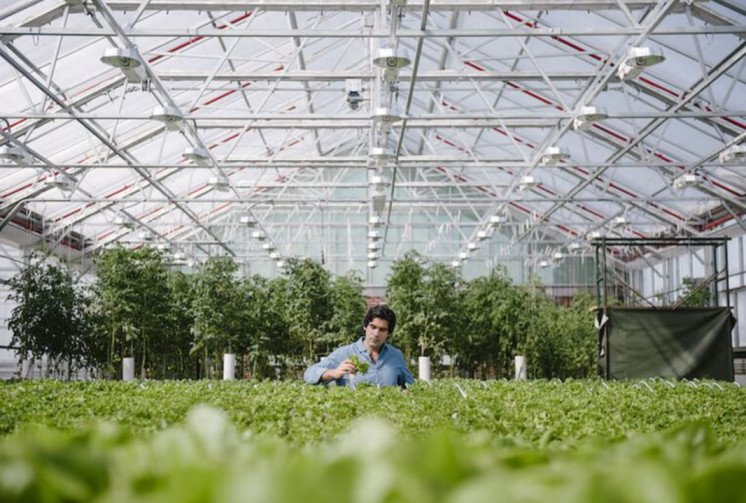In an era marked through rapid urbanization climate exchange & developing meals insecurity concept of vertical farming has emerged as groundbreaking method to number of maximum urgent challenges going through contemporary agriculture. This progressive approach to meals manufacturing guarantees to transform way we develop distribute & eat our meals offering glimpse right into more sustainable and efficient future for agriculture.
Vertical farming represents paradigm shift in agricultural practices transferring crop production from horizontal fields to vertical structures frequently within city environments. By stacking developing systems vertically this technique maximizes space performance and allows for yr round cultivation in managed environments. As we delve deeper into this topic well discover intricacies of vertical farming its capability advantages challenges & role it might play in shaping destiny of global food manufacturing.
Understanding Vertical Farming
Vertical farming is an agricultural method that involves growing crops in vertically stacked layers often incorporating controlled environment agriculture (CEA) technology. This method generally utilizes indoor farming strategies and technology based totally developing structures together with hydroponics aeroponics & aquaponics. number one aim of vertical farming is to produce extra food in line with square meter at same time as concurrently reducing environmental impact related to conventional farming techniques.
The idea of vertical farming isnt entirely new. Its roots can be traced lower back to ancient Hanging Gardens of Babylon one of Seven Wonders of Ancient World. However present day idea of vertical farming became popularized via Dr. Dickson Despommier professor of Public and Environmental Health at Columbia University in 1999.
Despommier and his college students proposed concept of developing meals in urban skyscrapers as option to feed growing population of New York City. Since then concept has developed rapidly pushed by improvements in technology and growing want for sustainable meals production strategies.
Types of Vertical Farming Systems
Vertical farming structures may be broadly categorised into 3 important kinds:
- Building based totally vertical farms: These are large scale operations housed in dedicated homes often repurposed warehouses or specially designed systems. They make use of artificial lights and climate control structures to create premiere growing conditions.
- Shipping field vertical farms: These are smaller modular systems built within widespread transport packing containers. They provide transportable and scalable answer for city farming.
- Home or network based structures: These are smaller setups designed for individual families or network agencies. They can range from easy window farms to greater complicated indoor gardening systems.
Technology Behind Vertical Farming
The achievement of vertical farming heavily relies on modern day technology that create premier growing situations for flora. Lets explore some of important thing technologies that make vertical farming possible.

Hydroponics
Hydroponics is way of growing plants without soil use of mineral nutrient solutions in water. In this system plant roots are suspended in nutrient rich water solution permitting them to take in necessary minerals for increase. Hydroponic structures are surprisingly efficient in water utilization usually use of up to ninety% less water than traditional soil based farming.
Aeroponics
Aeroponics takes soilless cultivation step further. In this machine plant roots are suspended in air and periodically misted with nutrient rich solution. This technique lets in for even more water efficiency and quicker plant growth because of improved oxygen publicity to roots.
Aquaponics
Aquaponics combines aquaculture (elevating fish) with hydroponics. In this symbiotic gadget fish waste gives nutrients for plant life whilst vegetation filter out water for fish. This closed loop machine is incredibly green and can produce both plant and fish products.
Lighting Systems
As many vertical farms operate indoors artificial lighting fixtures is important. LED (Light Emitting Diode) technology has revolutionized vertical farming by way of presenting power efficient customizable lighting answers. These lights can be tuned to particular wavelengths that optimize plant growth and improvement.
Climate Control
Maintaining top of line temperature humidity & CO2 degrees is critical for plant growth. Vertical farms hire sophisticated weather manipulate structures which can create ideal developing conditions year round irrespective of external weather situations. This technology allows for regular crop manufacturing and potential to grow plants out of doors in their herbal seasons or geographical places.
Benefits of Vertical Farming
Vertical farming offers severa blessings over conventional agricultural methods addressing most of demanding situations faced by using traditional farming within twenty first century.

Space Efficiency
One of maximum sizable blessings of vertical farming is its area performance. By stacking plants vertically those structures can produce considerably greater food consistent with rectangular meter than conventional farming methods. This efficiency is in particular treasured in city regions in which arable land is scarce and highly priced.
Water Conservation
Vertical farming systems in particular those use of hydroponics or aeroponics are rather water green. These closed loop structures recycle water lowering waste and keeping this precious resource. Some estimates advise that vertical farms can use up to ninety five% less water than conventional farming techniques.
Year spherical Production
By developing managed environments vertical farms can produce vegetation year spherical irrespective of external weather conditions or seasons. This regular production can help stabilize food materials and fees lowering effect of seasonal fluctuations.
Reduced Transportation Costs
Locating vertical farms in urban areas near consumers can significantly reduce transportation prices and carbon emissions related to lengthy distance food delivery. This proximity additionally guarantees more energizing produce with longer shelf lifestyles reducing food waste.
Pest and Disease Management
The controlled surroundings of vertical farms makes it simpler to manage pests and illnesses without using harmful insecticides. This outcomes in purifier healthier produce and decreases environmental impact associated with pesticide use in conventional farming.
Challenges and Limitations
While vertical farming gives many blessings it additionally faces several challenges that want to be addressed for significant adoption.
High Initial Costs
Setting up vertical farm calls for tremendous in advance investment in infrastructure generation & skilled hard work. high initial prices may be barrier to entry for lots capability farmers or investors.
Energy Consumption
Vertical farms rely closely on artificial lights and weather control systems that can result in excessive energy consumption. While improvements in LED era and renewable electricity assets are assisting to mitigate this difficulty power charges remain large project for lots vertical farming operations.
Limited Crop Variety
Currently vertical farming is maximum green for generating leafy greens herbs & few fruiting crops. Grains and other staple vegetation are still extra economically grown usage of conventional techniques. This challenge in crop range can effect overall viability of vertical farming as whole food manufacturing answer.
Technical Expertise Required
Operating vertical farm requires excessive degree of technical know how in regions such as hydroponics plant technological know how & climate control systems. This need for specialised abilities can be barrier to access and can limit vast adoption of vertical farming strategies.
Environmental Impact
Vertical farming has capacity to noticeably reduce environmental footprint of agriculture addressing number of important thing sustainability demanding situations faced with aid of world.
Reduced Carbon Footprint
By decreasing want for transportation and minimizing water usage vertical farms can drastically decrease carbon footprint associated with food production. Additionally controlled environment lets in for extra efficient use of sources further lowering environmental effect.
Land Use Efficiency
Vertical farmings space performance can assist maintain herbal habitats and reduce deforestation related to agricultural enlargement. By producing more meals in urban areas it may alleviate pressure on rural lands and contribute to biodiversity conservation.
Biodiversity Conservation
Traditional agriculture frequently leads to habitat destruction and biodiversity loss. By moving meals production into city areas and controlled environments vertical farming can help maintain herbal ecosystems and defend biodiversity.
Economic Implications
The upward thrust of vertical farming has big financial implications potentially reshaping city economies and international food systems.
Job Creation
Vertical farming creates new job possibilities in urban areas ranging from excessive tech roles in machine layout and management to positions in cultivation and distribution. This can make contributions to city economic improvement and provide new profession paths in agriculture.
Urban Development
The integration of vertical farms into urban landscapes can make contribution to city renewal initiatives doubtlessly increasing belongings values and creating new network spaces. It additionally gives possibilities for adaptive reuse of deserted homes or industrial areas.
Food Security
By imparting consistent neighborhood food source vertical farming can decorate meals safety in urban areas. This is specifically vital in regions with restricted arable land or ones prone to climate alternate affects on conventional agriculture.
Also read: Carbon Capture and Storage: Comprehensive Guide to Mitigating Climate Change 2024
Case Studies

Successful Vertical Farms Worldwide
Several successful vertical farming operations have emerged around sector demonstrating potential of this generation:
- AeroFarms (Newark New Jersey USA): One of largest indoor vertical farms within global AeroFarms makes use of aeroponics to grow leafy greens and herbs.
- Sky Greens (Singapore): This revolutionary farm uses rotating vertical towers to grow vegetables maximizing area in land scarce Singapore.
- Plenty (San Francisco California USA): Plentys farms use LED lights and machine studying to optimize crop increase generating excessive yields of leafy vegetables.
Lessons Learned from Failures
Not all vertical farming ventures were successful. Some remarkable disasters include:
- FarmedHere (Bedford Park Illinois USA): Once most important indoor vertical farm in North America FarmedHere closed in 2017 due to excessive running costs and competition from conventional farms.
- Podponics (Atlanta Georgia USA): This transport field based totally vertical farm filed for bankruptcy in 2016 highlighting demanding situations of scaling up and attaining profitability.
These cases underscore importance of careful planning sustainable business models & ongoing innovation inside vertical farming area.
Future Outlook
The destiny of vertical farming looks promising with ongoing technological advancements and growing hobby from investors and policymakers.
Emerging technologies including AI and gadget learning are being integrated into vertical farming structures optimizing crop growth and aid use. Innovations in LED lighting automation & plant genetics also are expected to enhance performance and productiveness of vertical farms.
As city planners an increasing number of focus on developing sustainable resilient cities vertical farming is possibly to play essential function. We may also see vertical farms incorporated into new constructing designs contributing to urban meals manufacturing and green spaces.
Potential for Space Exploration
Vertical farming technology are being explored for their ability programs in space exploration. NASA and other space groups are researching how those systems will be used to supply meals on long term area missions or destiny planetary colonies.
Vertical farming represents promising approach to many of demanding situations going through cutting edge agriculture. By maximizing space efficiency decreasing water usage & bringing meals production in direction of clients it gives route towards extra sustainable and resilient food systems.
Its critical to recognize that vertical farming is not panacea for all agricultural demanding situations. It should be viewed as part of assorted approach to food production complementing as opposed to changing conventional farming strategies.
As technology continues to boost and operational expenses lower we will assume to look wider adoption of vertical farming techniques. This increase will in all likelihood be pushed by means of growing urbanization weather alternate pressures & need for extra sustainable food production strategies.
The achievement of vertical farming will depend on ongoing innovation supportive rules & consumer recognition. As we pass ahead it will likely be crucial to cope with current boundaries of vertical farming while capitalizing on its strengths.
Ultimately vertical farming has potential to play large role in growing more sustainable green & resilient worldwide meals device. As we are facing demanding situations of feeding growing worldwide populace in an technology of climate uncertainty vertical farming gives glimpse of greener more food steady destiny.






